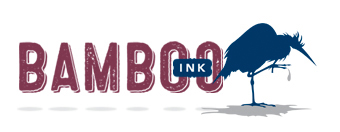What is die cutting?
In custom printing, die cutting is performed using a die, a razor-thin, razor-sharp steel blade, molded into a particular shape. When you press this die through paper (or other material), you impose the shape of the die onto the project you are printing.
Die cutting is a lot like making cookies.
Think of a die as a heavy-duty cookie cutter. The act of die cutting is similar to the act of pressing a cookie cutter into cookie dough to create a shape.
Unlike cookie cutting, die cutting with a custom printer like BambooInk is a whole lot faster and produces finely appointed precision cuts. Unfortunately for us, this type of die cutting doesn’t taste as good as die cutting cookie dough. Nor does it fill our print studio with the yummy aromas of baked goods. If you’d like that at home, check out this easy sugar cookie recipe.

What are the benefits of die cutting?
There are many benefits to die cutting and many options to explore. When working with a custom printer, die cutting is an automated operation which produces clean lines and edges and allows you to cut large quantities of paper at a time. Because it’s automated, it’s efficient and cost-effective.
At it’s most basic level, die cutting draws attention to functional and/or design elements within the piece being printed.
With die cutting, you can create:
- Unique shapes
- Unique objects
- Functional items like boxes, custom envelopes, and packaging
Imagine a wedding invitation with the shape of a heart “punched out” of the paper. Imagine hang tags attached to products sold at a craft fair like Richmond’s The Bizarre Bazaar®, all sorts of hang tags, from square cards with rounded edges and holes for threading ribbons to hang tags trimmed in the shape of wine bottles, dogs, or bicycles. Oval adhesive windshield stickers. Three-dimensional conference materials. Boxes cut to fold into exacting shapes, protecting a product for shipping and furthering corporate branding.
With a custom printer as your partner, some die cut products include:
- Custom printed business cards
- Custom printed invitations
- Custom printed brochures
- Hangers, danglers, and tags for doorknobs and mailboxes
- Adhesive items like magnets, labels, and cards
- CD sleeves
- Presentation folders
- Postcards and mailers
With die-cutting, the sky’s the limit.
And creative use of die cutting has saved our clients money. The nonprofit IMB needed to send kits to 50,000 churches within the United States, but the cost of the kit, box, and four folders of DVDs was getting too high. We worked with IMB to modify the kit so it could fit in a flat envelope instead of a shrink-wrapped box. Notice how the DVD now fits into a convenient sleeve within the folder. The changes saved IMB close to 70% in postage alone. (Click here to learn more about the IMB case study.)

BambooInk printed these presentation folders for the IMB with a die cut DVD slit.
What die-cut shapes are available?
BambooInk has over 600 dies currently available. Don’t see one that will work for your project? We can create a custom die to achieve exactly the look you want.
A custom printer would typically use dies in geometric shapes and organic shapes.
Die cutting geometric shapes
Geometric shapes are pretty straightforward: squares, rectangles, triangles, circles, ovals.
Two tips to keep in mind:
- Geometric shapes can be angular or rounded.
- Geometric shapes need to have precise measurements.
Die cutting with organic shapes
Shapes formed naturally are considered “organic.” Think leaves, trees, animal shapes.
How is die cutting with organic shapes different than geometric shapes?
Die cut organic shapes are usually created as an outline of an object (e.g., a stately deer). Because organic forms tend to follow an outline, they do not have precise measurements the way a geometric would have.

What are the types of die cuts?
Here’s a glossary list of the different types of die cuts:
Edge cuts
Cuts made to the outer boundary of your print material; ultimately determines the shape of the object.
Slits
Nifty cuts made to secure media; for instance, business card inserts inside a folder or presentation package.
Pockets
Think binders, report covers, folders; anything designed to hold or store things like paper or other printed materials.
Corner cuts
Cuts that modify shape slightly through rounded edges and or corners; often used to prevent fraying and dog-earing.
Window cuts
Decorative shapes often created on the outside of media and used to reveal design elements inside the media.
Openings and closures
Tabs, inserts, and gates that fold a particular way are often die cut to manipulate the way a product is opened and closed.
Die cutting is a finishing process.
Die cutting is one of may finishing services we offer our customers. In addition to die cutting, we offer:
- Embossing
- Foil stamping
- Laminating
- Perforating
- Shrink wrapping
To learn more about our capabilities in printing, finishing, bindery, fulfillment, as well as mailing and shipping, give us a ring. We’d love to help you explore options in die cutting and all our printing and finishing methods.
Did you know?
The technology for die cutting was originally developed during the industrial revolution as a means of mass producing leather inserts in shoes.
So there you have it. Answers to your frequently asked questions about die cutting—from cookie cutting to shoe production and everything in between.

